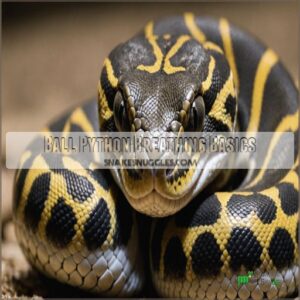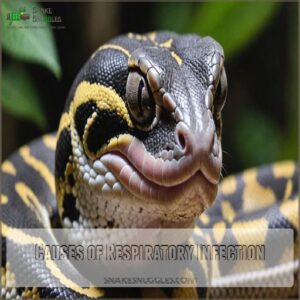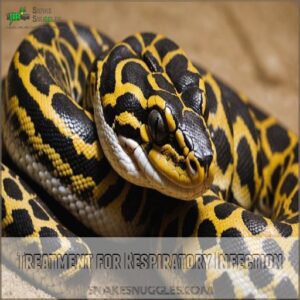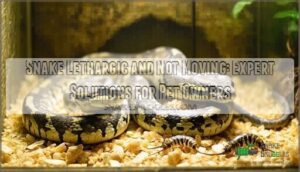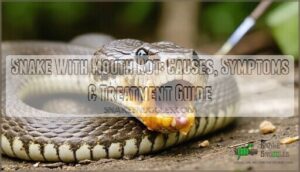This site is supported by our readers. We may earn a commission, at no cost to you, if you purchase through links.
 Noticing your ball python taking deep breaths? Don’t hit the panic button just yet! After a hearty meal, they often need a few deep breaths to help with digestion.
Noticing your ball python taking deep breaths? Don’t hit the panic button just yet! After a hearty meal, they often need a few deep breaths to help with digestion.
However, if you’re hearing wheezing or raspy sounds along with those breaths, your snake might have a respiratory issue like Inclusion Body Disease. Kind of like when Uncle Bob gets winded after turkey dinner, but with potential health concerns. Keep an eye (or ear) out for unusual sounds and any changes in behavior. If things seem amiss, consulting a vet is wise.
Wondering what else to watch for? Keep reading!
Table Of Contents
- Key Takeaways
- Ball Python Breathing Basics
- Why Ball Pythons Take Deep Breaths
- Respiratory Infection in Ball Pythons
- Differentiating Between Normal and Abnormal Breathing
- When to Seek Veterinary Care
- Maintaining a Healthy Environment
- Preventing Respiratory Issues
- Addressing Underlying Health Issues
- Frequently Asked Questions (FAQs)
- Why do ball pythons breathe deeply?
- Can ball pythons get respiratory infection?
- What should I do if my ball python is sick?
- Why does a ball python make a wheezing noise?
- How do you treat a baby ball python respiratory infection?
- How to care for a ball python?
- Why is my ball python taking deep breaths?
- What are the signs of respiratory distress in a ball python?
- What does a respiratory infection sound like in a ball python?
- Should I be able to hear my ball python breathe?
- How does diet affect ball python breathing?
- Can dehydration cause deep breathing in pythons?
- Do seasonal changes impact python breathing patterns?
- How does age influence breathing in ball pythons?
- Can loud noises lead to heavy breathing in pythons?
- Conclusion
Key Takeaways
- Notice your ball python taking deep breaths after meals—it’s normal for digestion, but if it persists, check for stress or respiratory issues.
- Keep an ear out for wheezing or gasping sounds, as these might indicate respiratory infections requiring vet attention.
- Ensure your snake’s habitat has proper temperature, humidity, and ventilation to prevent breathing issues and maintain health.
- If heavy breathing or unusual behavior continues, consult a vet to rule out serious health concerns like respiratory infections.
Ball Python Breathing Basics
Understanding your ball python’s breathing patterns is essential to guarantee its health and well-being.
You’ll soon master the art of distinguishing a subtle sigh from a worrying wheeze, guaranteeing your pet can breathe easy.
Normal Breathing Noises
In the serene world of ball pythons, normal breathing might include faint whistling, raspy, or even crackly undertones, almost like a gentle sigh.
Don’t fret; these noises aren’t alarming.
Your scaly buddy uses its respiratory system just like any of us, taking breaths that sometimes sound wheezy.
As long as they’re active and content, there’s usually no cause for concern.
Abnormal Breathing Noises
While normal breathing in ball pythons is nearly silent, abnormal breathing noises like wheezing or gasping mean it’s time to act.
These sounds could hint at respiratory infections or blockages.
You can learn more about the common causes of such issues, including respiratory infections, by seeking veterinary advice.
Be alert for heavy breathing paired with open-mouth motions.
Early diagnosis and treatment are key.
Observing your pet’s respiratory health diligently prevents severe issues, ensuring a happy, slithering friend.
Why Ball Pythons Take Deep Breaths
You might notice your ball python taking deep breaths for a few reasons, ranging from finishing a hearty meal to dealing with stress or a more serious respiratory infection.
It’s important to understand these causes so you can provide the right care and keep your scaly friend healthy and happy.
After Eating
Many ball pythons take deep breaths after a big meal.
It’s part of their snake digestion process.
Their bodies are hard at work, so don’t disturb them!
Give your snake at least 24-72 hours of peace and quiet after feeding.
Observe their breathing; heavy breathing could signal a problem.
A regular feeding schedule helps, too.
Remember, a happy snake is a healthy snake!
Due to Stress
A ball python taking deep breaths could be signaling stress, possibly due to stressful handling or enclosure issues.
It’s like your snake saying, "Give me a break!"
Anxiety triggers, such as too much handling or lack of hiding spots, can lead to stress signals.
You can find various products designed to help alleviate ball python stress, such as those found in ball python stress-relief guides and kits ball python stress products.
Make sure the enclosure mimics natural conditions to support their respiratory health and overall well-being.
Respiratory Infection
Stress might make your snake breathe heavily, but if it’s persistent, watch out for respiratory infection.
You’ll notice labored breaths, wheezing, or mucus.
Keep an eye on temperature and humidity; they’re not just decorations.
Consult a vet when symptoms persist.
Preventing respiratory issues like wheezing or open-mouth breathing, which can be caused by incorrect humidity levels or temperature fluctuations, can be addressed through annual check-ups with a ball python vet. Preventing respiratory issues with proper care keeps your ball python healthy and limits veterinary visits.
Respiratory Infection in Ball Pythons
Respiratory infections in ball pythons can cause labored breathing and other concerning symptoms, making it important to spot early signs.
If your snake is audibly wheezing or displaying open-mouth breathing, it’s time to think about a trip to the vet.
Causes of Respiratory Infection
You might wonder why your ball python is taking those deep breaths.
Well, respiratory infections often result from incorrect temperature and humidity in their enclosure.
A reptile humidifier can help maintain the right humidity levels, which is essential for their respiratory health.
Throw in some poor hygiene and an unbalanced diet, and you’ve got a recipe for stress and health issues.
Keep their space ideal, tidy, and their diet healthy to fend off infections effectively.
Signs of Respiratory Infection
Spotting a respiratory infection in ball pythons requires a keen eye.
Look for mouth breathing or nasal discharge; these are telltale signs.
Is your python showing lethargy, appetite loss, or weight loss?
These symptoms often accompany labored or heavy breathing.
Quick observation can prevent serious snake illness symptoms, ensuring your slithery companion’s quick recovery and continued health.
Treatment for Respiratory Infection
Breathing normally is a symphony; when your ball python hits a sour note, act quickly.
Antibiotic therapy is often needed to combat respiratory infections. Snake veterinary care may include snake antibiotics or hospitalization.
Prognosis improves with early action. For home care, provide warm, clean conditions.
Prevention tips? Maintain ideal habitat conditions to avoid these scaly struggles.
Differentiating Between Normal and Abnormal Breathing
You’ll need to carefully observe your ball python’s breathing patterns to distinguish between normal and abnormal respiration.
Understanding these differences is key for identifying potential health issues and providing appropriate care, ensuring your scaly friend stays happy and healthy.
Observing Body Language
Respiratory infections might make you uneasy, but reading your ball python’s body language adds insight.
Notice their posture: a relaxed coil suggests normalcy, whereas puffed sides might hint at stress.
Watch eye position for tension.
Tail movements can indicate distress, while scent marking shows nervousness.
Even head tucking offers clues.
Understand these signals to keep your scaly friend stress-free.
- Posture Analysis
- Eye Position
- Tail Language
- Scent Marking
- Head Tucking
Monitoring Behavior
As you observe your ball python, keep an eye on subtle changes in snake body language and behavioral patterns that might indicate stress or discomfort.
Heavy breathing, lethargy, or changes in eating habits might be linked to environmental stressors or social interaction issues.
Consistently monitor your snake’s environment and maintain ideal conditions to prevent respiratory infections and promote overall health.
Recognizing Warning Signs
Spotting trouble in your ball python’s breathing patterns doesn’t require a magnifying glass.
If you notice your snake wheezing or breathing heavily, it might be waving a little red flag. Keep an eye out for open-mouth breathing and other respiratory health signs.
Environmental warning signs like drafts might trigger symptoms of snake respiratory disease, such as open-mouth breathing or wheezing, which are clear indicators of respiratory distress signs. Environmental warning signs like drafts might trigger these symptoms, signaling potential respiratory infections.
Stay alert and intervene early.
When to Seek Veterinary Care
If your ball python is displaying labored breathing or persistent deep breaths, it’s time to consult a veterinarian.
Don’t ignore changes in behavior like increased lethargy or lost appetite, as these could signal a serious health issue.
Labored Breathing
Is your ball python struggling to breathe? Labored breathing, like open-mouth breathing or gasping, is a serious Stress Indicator.
A ball python taking deep breaths or frequently yawning might be a sign of stress or illness in ball pythons, as excessive yawning can be a cause for concern, especially when accompanied by other symptoms. This isn’t normal Snake Behavior.
Don’t delay; a vet visit is critical. Ignoring labored breathing can lead to a respiratory infection or even a snake virus.
Quick action gives your scaly friend the best chance at recovery. Monitor Breathing Patterns closely.
Immediate veterinary care is essential for successful treatment.
Persistent Deep Breathing
Labored breathing isn’t just a quirk—persistent deep breaths might spell trouble for your ball python, especially if it’s related to respiratory issues like IBD. Heavy breathing could indicate a respiratory infection or other health issues.
You shouldn’t brush off changes in breathing patterns. When these deep breaths stick around, it’s time for a vet visit.
Make sure your pet’s environment is spot on to avoid unnecessary stress and keep them healthy.
Changes in Behavior
Noticing a ball python’s behavioral quirks, such as rapid tongue flicking or head shaking which can be signs of stress in ball pythons (Signs of Stress), can be subtle but crucial.
If your snake suddenly loses interest, shows appetite changes, decreases activity, or increases social avoidance with hiding more often, it’s a clue something’s amiss.
Heavy breathing paired with a gurgling noise might point to health issues.
Check the temperature and humidity levels, and consult a vet if these signs persist.
Maintaining a Healthy Environment
To keep your ball python happy and healthy, you need to maintain an environment that meets its needs.
This means regulating temperature and humidity, ensuring proper ventilation.
Keeping the enclosure clean is also crucial, so your snake doesn’t throw a "hissy fit.
Regulating Temperature and Humidity
So, your vet visit’s done. Now, let’s focus on your ball python’s home.
Maintaining the right temperature and humidity is key, and a good starting point is understanding the ideal ball python temperature humidity.
Aim for a consistent temperature gradient, using reliable heat sources.
Monitor humidity levels closely; too much or too little can cause problems.
Proper ventilation helps maintain these levels.
Think of it like Goldilocks – not too hot, not too cold, just right!
Remember, consistent conditions are essential for a happy, healthy snake.
Providing Adequate Ventilation
Think of your snake’s enclosure as its own little world.
The right enclosure design, complete with good ventilation materials, is key to promoting fresh air circulation.
It helps prevent ventilation issues that can lead to heavy breathing.
By ensuring proper airflow patterns, humidity control becomes manageable, creating a spacious habitat that minimizes overcrowding and fosters a healthy environment.
Keeping The Enclosure Clean
Proper ventilation’s key, but maintaining a pristine enclosure keeps respiratory issues at bay.
Regular Enclosure Cleaning boosts your python’s health.
For a hassle-free experience, consider shopping for a reliable Ball python enclosure cleaner(Ball python cleaner) online.
Embrace the art of cleanliness with:
- Substrate Choice: Pick one that’s easy to replace and absorbs messes.
- Cleaning Schedule: Stick to a routine.
- Hygiene Practices: Use safe Disinfectants.
These steps ward off disease, ensuring happy, healthy snakes!
Preventing Respiratory Issues
To keep your ball python breathing easy, focus on a spacious habitat and avoid overcrowding to reduce stress.
Stress can lead to respiratory issues in ball pythons.
A proper diet and good nutrition also play a key role in preventing respiratory issues.
Spacious Habitat
Balancing enclosure size with your ball python’s needs is essential in preventing respiratory issues.
A spacious habitat allows for proper air circulation, reducing risks of heavy breathing.
Prioritize thoughtful habitat design with well-placed hides and suitable substrate choices.
While considering space requirements, remind yourself to balance vitamin D and calcium in their diet for overall well-being.
Maintain a practical, pleasing environment.
Avoiding Overcrowding
To keep your ball python from heavy breathing (and you from worrying), never forget the importance of space.
Overcrowding is a recipe for stress, with your snake feeling cramped and edgy.
Make sure your enclosure size accommodates not just the snake but also any tank mates with room for social interaction.
This reduces stressors, keeping your python happy and healthy.
Proper Diet and Nutrition
Ever wondered why diet matters for your ball python’s breathing?
A balanced diet isn’t just about keeping it full—avoiding nutritional deficiencies helps prevent respiratory issues too.
Focusing on dietary variety with the right prey size, frequency, and occasional supplements helps your snake stay healthy and vibrant.
Plus, it’s a simple way to ward off infections from snake bacteria.
Addressing Underlying Health Issues
Sometimes, deep breaths aren’t just about stress; they can signal a hidden health problem. Let’s explore how to identify potential underlying issues and get your scaly friend the best care.
Identifying Underlying Causes
Heavy breathing in your ball python might signal underlying issues.
Stress from poor ventilation or incorrect enclosure size can cause discomfort.
Lethargy and loss of appetite, as discussed in snake diseases, can also indicate larger health problems.
Keep an eye on diet and hygiene, as a contaminated water supply could lead to inclusion body disease.
Notice any weight loss or excess mucus? These symptoms warrant a closer look, ensuring everything in their habitat supports their health.
Seeking Professional Help
Wondering when to seek professional help for your ball python’s heavy breathing?
Look for signs like swelling or discharge from the nose and mouth.
- Vet Visit Checklist – Prepare questions and note symptoms.
- Snake Health Insurance – Consider options for costly treatments.
- Herp Vet Directory – Find specialists nearby for expert care.
Implementing Preventative Measures
You’ve consulted a vet, so let’s safeguard your ball python together.
Tackle prevention with gusto!
Keep humidity and temperature in check, guarantee proper snake hygiene, and maintain air quality with solid enclosure design.
Implement these measures to curb heavy breathing.
A healthy diet works wonders too!
| Prevention Measure | Benefit |
|---|---|
| Humidity Control | Prevents respiratory issues |
| Temperature Checks | Assures best environment |
| Enclosure Design | Promotes air quality |
| Clean Enclosure | Reduces disease risk |
| Healthy Diet | Supports overall health |
Frequently Asked Questions (FAQs)
Why do ball pythons breathe deeply?
Don’t panic! Deep breaths aren’t always bad.
Ball pythons breathe deeply after eating, due to digestion, or from stress.
Check their environment; a vet visit might be needed if it persists.
Can ball pythons get respiratory infection?
Ball pythons can indeed get respiratory infections, often due to incorrect temperature and humidity levels or poor hygiene.
Symptoms like labored breathing or mucus discharge require prompt veterinary care.
A clean, properly maintained habitat helps prevent issues.
What should I do if my ball python is sick?
If your ball python’s feeling under the weather, first make sure its habitat is perfect—ideal temperature, humidity, cleanliness.
Then, consult a vet promptly to pinpoint issues like respiratory infections or parasites, ensuring effective treatment and recovery.
Why does a ball python make a wheezing noise?
Your ball python might wheeze from respiratory infections, overheating, or blockages.
Make sure to maintain proper temperature and humidity.
Keep the enclosure clean and stress-free.
If wheezing persists, it’s wise to consult a vet for further diagnosis and care.
How do you treat a baby ball python respiratory infection?
To treat a baby ball python‘s respiratory infection, consult a vet promptly.
They’ll likely prescribe antibiotics and possibly hospitalization for severe cases.
Meanwhile, optimize its enclosure’s temperature and humidity, ensuring it’s clean and stress-free.
How to care for a ball python?
Caring for a ball python involves maintaining the right temperature and humidity.
Providing a spacious, clean enclosure is also crucial.
Offering a balanced diet is another important aspect of care.
Regular check-ups with a vet help your slithery friend stay healthy and happy.
Why is my ball python taking deep breaths?
A ball python taking deep breaths might be digesting, adjusting to new conditions, or experiencing mild stress.
Still, make sure proper temperature and humidity are maintained.
If heavy breathing persists or is labored, consult a vet for potential respiratory issues.
What are the signs of respiratory distress in a ball python?
Don’t panic!
Watch for open-mouth breathing, gasping, or wheezing.
These are major red flags indicating respiratory distress.
Rapid, shallow breaths are also a warning sign.
Seek vet help immediately if you see these symptoms.
What does a respiratory infection sound like in a ball python?
A respiratory infection in a ball python can be caused by low humidity issues, such as dry air leading to respiratory problems. A respiratory infection in a ball python sounds like wheezing or gurgling when breathing.
You’ll notice labored breathing, and sometimes, open-mouth breathing.
These distinct sounds should prompt you to seek veterinary care for proper evaluation and treatment.
Should I be able to hear my ball python breathe?
Funny how snakes are silent, yet you shouldn’t hear your ball python breathe too loud.
If you do hear wheezing or gasping, it could mean trouble like a respiratory infection.
A vet check might be wise.
How does diet affect ball python breathing?
A ball python’s diet, which may be impacted by stress, temperature or humidity changes, shedding cycles, and old age, as seen in signs of an unhealthy ball python, is particularly important. Your ball python’s diet impacts its breathing by influencing overall health.
A balanced diet prevents nutritional deficits, reducing stress and ensuring a strong immune system.
Poor nutrition can lead to illness, affecting respiration and well-being.
Can dehydration cause deep breathing in pythons?
Dehydration can indeed cause deep breathing in pythons as they try to regulate body functions.
Maintaining proper humidity levels in their enclosure also helps prevent dehydration.
Make sure your python has constant access to fresh water.
Do seasonal changes impact python breathing patterns?
How do seasonal changes impact python breathing patterns?
Changes in temperature and humidity, typical of seasonal shifts, can challenge a python’s breathing.
Maintain stable conditions to help prevent respiratory issues and maintain their overall health and well-being.
How does age influence breathing in ball pythons?
Age affects ball python breathing as younger snakes may exhibit faster breathing rates due to their higher metabolism.
Older ones may show heavier breathing after exertion.
Always make sure their environment supports healthy oxygen levels, minimizing stress.
Can loud noises lead to heavy breathing in pythons?
It’s a strange coincidence, but yes!
Sudden loud noises can definitely stress your python, triggering heavy breathing.
Think of it like your own startled gasp.
Observe your snake’s environment for potential stressors.
Conclusion
Caring for a ball python taking deep breaths involves some detective work to sort normal from concerning signs.
Remember, after a meal, deep breathing can be normal, but wheezing or persistent changes could signal trouble.
Keep a close watch on your snake’s behavior and environment, making sure proper humidity and temperature are maintained.
If you notice labored breathing or unusual sounds, don’t hesitate to consult a vet.
It’s better to be cautious and make sure your scaly friend stays healthy and happy.

